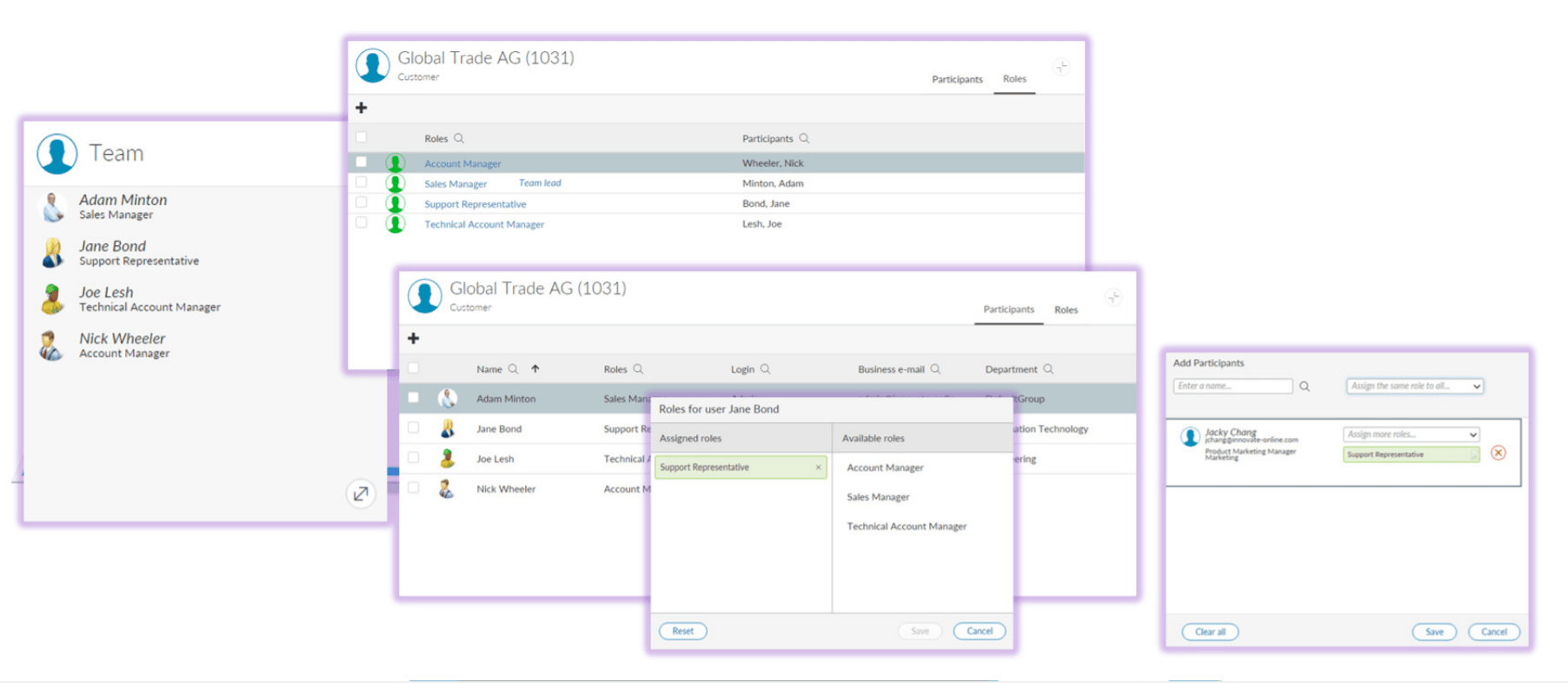In today’s post, we would like to talk about how you can optimize document-based collaboration processes between your company’s business users by creating custom landing pages, workspace teams, and smart project-based OpenText Connected Workspaces in Content Suite 16. Not only will this allow your business users to tremendously reduce the time they spend searching for information, but it will also allow you to speed up any document-based work processes. Your business users will love you for these improvements.
Introducing OpenText Connected Workspaces in OpenText Content Suite 16
Many organizations still heavily rely on paper or email to distribute project-related information. As a result, staff members often end up chasing documents and searching for relevant information across multiple functions. This not only takes a lot of time and causes delays, but also raises the risk of regulatory non-compliance. In order to fix this situation, employees reach out to their IT department and burden them with requests to develop and manage custom, internal applications that have a very narrow focus.
If your company experiences similar issues, you need to read this article and learn more about OpenText Connected Workspace, an Content Suite Platform module. Connected Workspaces provide a compliant area to exchange information without relying on an overburdened IT department. Workspaces can be related to each other within the ECM system or can be used to extend ECM to leading enterprise suites like SAP, Microsoft SharePoint, or Salesforce.
Let’s talk about Functionality
OpenText Connected Workspaces uses pre-built templates and a visually driven Smart View UI to create customized areas to share and access the content needed for a common task or goal. The attractive user interface provides business-centric perspectives and widgets. Content managed within the workspaces can be shared with contractors, partners or external parties, without compromising enterprise control and security.
The module provides powerful tools with great flexibility for the administrator and, the business rules save the end-users a lot of work, the business rules and templates also drive the new role-based Smart View user interface. Social-based collaboration tools are built-in, fostering adoption because end-users don’t have to switch between different tools.
Customizable landing pages
Depending on their job and department, end-users in different functional areas within the same organization have completely different needs. Furthermore, users want to see business objects that are relevant to their daily work right in front of them in a dashboard. Content Server supports all of those requirements and offers different landing pages that meet the needs of different groups based on configurable rules.

Workspace types and perspective
Some of you may be wondering: isn’t Connected Workspaces just a fancy name for a simple folder with some business documents? No it’s actually much, much more. A workspace can have business relationships with other workspaces based on both metadata and content metadata. In addition, a workspace has its own team that enables control over the participants at company level. It stores documents, emails and other content. It summarizes all messages and events in a user-friendly way and supports collaboration in cases with checklists and workflows. Different types of workspaces have different configurations. Depending on the business requirements, information can be provided in a dedicated manner.
Workspace team
A team in Workplaces represents roles within an organization or a business process. Each workspace has its own team. Business users can assign participants directly without involving the IT department. The use of team roles for access control offers security, maintainability, and flexibility at the same time.

Business Benefits at a Glance
Access Connected Workspaces
When using Connected Workspaces, an administrator creates workspace types and prepares workspace templates. On the landing page, end-users have “workspace titles” that they can use to navigate to workspaces. The following sample page contains three different widgets that reference customers, opportunities, and sales orders.
The reduced view shown here contains the recently opened workspaces and preferred elements that can be opened directly from here. You can quickly filter the elements by clicking the magnifying glass icon in the header of the widget. Filtering takes place automatically in the background as soon as you stop typing. Click the extension element in the lower right corner of the widget to access other elements or if there are no workspaces yet.
Aligning teams, content and collaborative business processes
Organizations often face inefficiency issues with paper-based processes, email, shared drives, and proprietary departmental solutions for information access and collaboration. This leads to unnecessary delays and wrong decisions due to forgotten, inaccessible and inaccurate content. With Connected Workspaces, authorized users workers can set up dedicated workspaces that summarize the information, team members, and workflows they need. Replacing manual tasks with modern, digitized content workflows improves productivity and lowers costs. The workspace-based model not only provides a coherent opportunity to share and collaborate, it also prevents the loss of intellectual property by professionals and enables teams to more effectively achieve common business goals.
Ad hoc information exchange with automated governance
While many companies use consumer chat tools, these applications are often difficult to control and vulnerable to security breaches. Companies are therefore exposed to the risk of IP and compliance losses. With Connected Workspaces, industry-leading OpenText methods for data record management are embedded in every workspace in order to control the relevant content automatically and transparently. Customizable user permissions define who can see what, while audit trails allow you to report on access and changes. The solution enables teams to collaborate freely and share important business information while ensuring that metadata and classifications are added to the data set. By automating the application with transparent rules and classifications for data record management (without user intervention), companies can easily integrate workspaces into their information management strategy.
Free up valuable IT resources
Users can easily set up workspaces for any repeatable process. To create a new, case-based workspace, all you have to do is select the most suitable template, enter the basic information and assign users to predefined roles. This new workspace is added to each member’s personal dashboard and provides quick access to the cases they participate in and the tasks they need to perform. Additional dashboards can be created to provide managers with information on the status of multiple initiatives at a glance. By implementing Connected Workspaces, collaboration between remote teams and locations is significantly simplified without burdening the IT department.
Integrating content to lead applications
Business processes are the lifeblood of an organization, but no single process works in a vacuum. It is frustrating for knowledge workers if they cannot easily access important, everyday business information stored in leading business applications such as SAP, Oracle, and Salesforce, and instead waste time and resources relying on others. With OpenText Extended ECM, Connected Workspaces can be integrated into the main applications in which information is created and saved. This information can be fed into the workspace itself to give users direct, permission-based access to information related to the task at hand. Users benefit from being able to access current, accurate data in real time without ever leaving the application or interface in which they work. By allowing business users to self-manage solutions to meet their needs, Connected Workspaces fundamentally changes the way content services are delivered to minimize training needs, increase user adoption, and increase team productivity. With Connected Workspaces, companies significantly improve team collaboration by aligning content with business processes and at the same time eliminating the compliance risks associated with ad hoc communication.
With all these new capabilities of Connected Workspaces, there’s no better time to upgrade to Content Suite16 than now!
Are you still on OpenText Content Suite Platform 10.5? If you wanna take advantage of the above-mentioned functionality of Connected Workspaces you have to upgrade to version 16.2. Please be aware that version 10.5 moved into the sustaining maintenance phase of its product lifecycle on March 1, 2019. Customers with active maintenance on Content Suite or Content Server receive access to new releases of the software at no charge. Find the release dates and subsequent sustaining maintenance for your OpenText products by visiting the Product Support Lifecycle page on OpenText My Support (customer login required) or simply reach out to our experts and request more information.
Accelerate your upgrade and reduce risk by working with Ecodocx’s OpenText experts. Customers who have Ecodocx’s OpenText Professional Services-led upgrades or other implementation projects report 75% fewer queries to Customer Support. Let our experts work with your in-house team to assess the current environment and prepare recommendations for a successful upgrade, whether on‐premises, in cloud, or a hybrid environment. To learn more, view our OpenText Upgrade Services page, OpenText Professional Services page or simply contact us directly.


